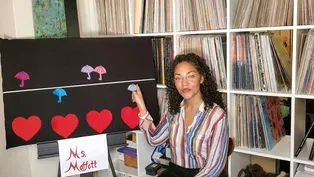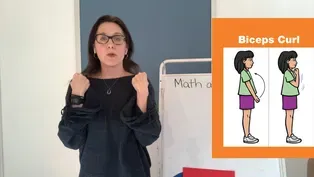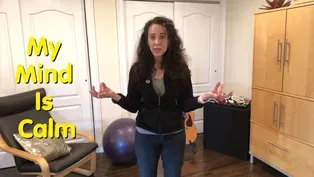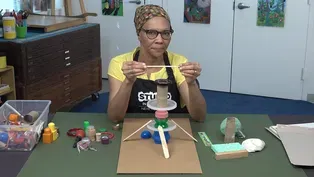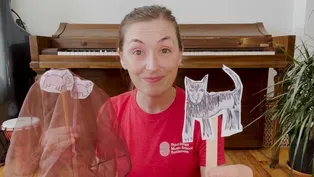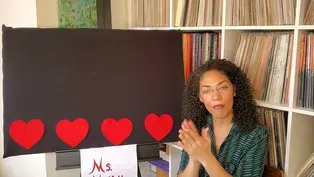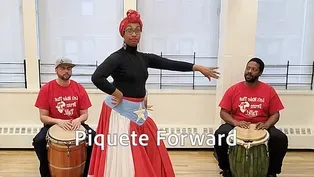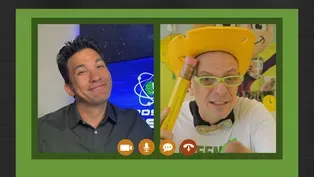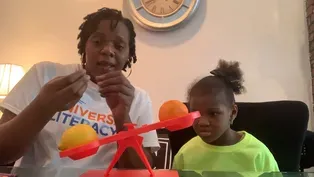
What Letters Do You See in Find?
1/22/2021 | 55m 18sVideo has Closed Captions
Think like a computer, make a cloud dance, read NERDY BABIES: OCEAN.
Think like a computer, make a cloud dance, read NERDY BABIES: OCEAN, blend and decode short i, r, f, & final s. LET’S LEARN helps children ages 3-8 with at-home learning. One-hour programs feature instruction by educators and virtual field trips.
Problems with Closed Captions? Closed Captioning Feedback
Problems with Closed Captions? Closed Captioning Feedback
Let's Learn is a local public television program presented by THIRTEEN PBS

What Letters Do You See in Find?
1/22/2021 | 55m 18sVideo has Closed Captions
Think like a computer, make a cloud dance, read NERDY BABIES: OCEAN, blend and decode short i, r, f, & final s. LET’S LEARN helps children ages 3-8 with at-home learning. One-hour programs feature instruction by educators and virtual field trips.
Problems with Closed Captions? Closed Captioning Feedback
How to Watch Let's Learn
Let's Learn is available to stream on pbs.org and the free PBS App, available on iPhone, Apple TV, Android TV, Android smartphones, Amazon Fire TV, Amazon Fire Tablet, Roku, Samsung Smart TV, and Vizio.
Providing Support for PBS.org
Learn Moreabout PBS online sponsorshipMore from This Collection
Video has Closed Captions
Read SCHOOL BUS and draw one, learn about prefixes and pitch, build sculptures. (57m 48s)
Running and Counting Both End in “ing”!
Video has Closed Captions
Move to improve, find the missing number, learn songs from Ghana, read ABUELITA’S SECRET. (58m 17s)
What Sound Does “aw” Make in Draw?
Video has Closed Captions
Read a story, discover "au" and "aw," learn about density, count, and move with music. (56m 58s)
Can You Find the Short “u” in Subtract?
Video has Closed Captions
Help Super Grover 2.0 solve a prickly problem, read ALL THE WAYS TO BE SMART. (56m 19s)
What Sound Does “gl” Make in Glove?
Video has Closed Captions
Play the glockenspiel, help Super Grover 2.0 make a cart move, read TWO WOOL GLOVES. (58m 9s)
Incredible Starts with Short “i”!
Video has Closed Captions
Solve problems with Super Grover 2.0, catch a rainbow, hear a piano sound like a cuckoo. (56m 9s)
What’s the Sound of “oo” in Book?
Video has Closed Captions
Explore animals’ form and function, sing about the 3 little pigs, read THE LITTLE BOX. (58m 15s)
We’re Reducing, Reusing and Recycling!
Video has Closed Captions
Learn all about rhythm and the number 9, read A BAG IN THE WIND. (56m 17s)
Video has Closed Captions
Learn to dance bomba and grow food in a city, read WOLF CUB’S SONG. (55m 20s)
How Many Syllables are in Invent?
Video has Closed Captions
Invent your own instrument, make 10 to add numbers to 20, read ONE GOLDEN RULE AT SCHOOL. (57m 36s)
Video has Closed Captions
Learn about the science behind mind reading, count shells, read MY BIG FAMILY. (57m 27s)
Which is Heavier: One Apple or Two Apples?
Video has Closed Captions
Defy gravity, learn secret code words for fast and slow in music, read WHOOO KNEW? (58m 5s)
Providing Support for PBS.org
Learn Moreabout PBS online sponsorship[upbeat music] - [Announcer] Ready to learn?
- Hi!
- [Announcer] It's time to share a story, [teacher shushing] read and write.
- Let's read it back, - [Announcer] discover science, sing, ♪ Somewhere!
♪ play, and so much more!
- Cupcakes!
- Very good!
- [Announcer] Stay tuned for lessons and activities.
- We're going to start making some words, isn't that fun?
- [Announcer] Funding for this program was provided by the JPB Foundation.
- Hi friends, welcome to Story Time with me, Ms. Darlene.
Today's read aloud is from the "Nerdy Babies" book series.
The title is called "Ocean," written and illustrated by Emmy Kastner.
What's really great about this book is that it is an informational text which means we are about to learn some really cool facts about the ocean.
And when I learned new facts, I like to either take notes or draw an informational picture.
That's where you take some information that you've learned from the book, you make your own picture and you write words explaining it to someone.
After the read aloud, I'll show you how you can make your own informational picture at home.
So if you're ready, put on your imaginary diving gear and let's have fun reading!
Hey there nerdy babies, do you ever wonder about the ocean?
You probably do, you're curious!
Well, we're curious, we explore to find information about new things.
See that blue stuff on Earth?
Green is the land, and the blue stuff is the ocean.
Usually in an informational text, you'll see a picture of something with words and an arrow pointing to it.
The words are usually explaining what's in the picture.
Let's keep reading to find out what other cool facts we can learn in the book.
Off the coasts, swirling between each continent on our planet, you will find the ocean.
Wow, the ocean has a lot of things happening.
Deep in the ocean, on the surface of the ocean, and even above the ocean, a lot of researchers even spend a lot of time studying the ocean so they can bring new information back to us.
Most of our planet is covered in salt water.
That's not the kind that we drink.
Some animals live on the shore and find food in the ocean.
[gasping] Here's a nerdy baby on the shore.
It looks like he's spotted one of them!
He says, "Bird!"
and there's a seagull.
And this nerdy baby, looks like he's discovered a crab.
At the surface you may find animals peeking up who need air to breathe or a place to sleep.
[gasping] Do you see the seal sleeping with a nerdy baby?
[shushing] The water is warmed by the sun.
This nerdy baby wonders, "What's down there?"
Do you wonder what's down there?
Let's take a look and see.
Just below the surface you'll find plants and animals that need light from the sun to live and grow.
Wow, all of those beautiful plants and animals.
Thus nerdy baby says, "You can see this reef from the moon!"
It's so bright and beautiful.
This nerdy baby says, "There are so many fish!"
And that's true, there's lots of fish in the ocean.
A little deeper marine life is on the move.
Animals migrate all over the world.
There's plenty to eat along the way.
When we migrate, that means that we're moving from one place to another, like the leatherback sea turtle who swims to distant beaches to lay their eggs.
And on the way they feed on lion's mane jellyfish.
this nerdy baby says, "It's chilly down here!"
Blue marlin travel far following the food.
They like to feed on mackerel.
And gray whales head south for the winter.
They feed on krill.
Do you notice this pinkish reddish plume of smoke?
Well, that's not really smoke.
You can't have smoke in the ocean!
But they're actually really tiny red sea creatures that look like shrimp that traveled together making it easier for the gray whales to see them and eat them!
Most of the ocean is cold.
Some fish are cold blooded, their bodies adjust to match the warm and cold water.
There's a baby asking, "Why aren't you cold?"
Well, what do you notice this nerdy baby is wearing to keep warm?
That's right, a coat.
We wear coats when we're cold as humans, but back on the surface, other marine animals have thick fur, like the polar bear, or blubber, which is a thick layer of fat, like the beluga whale, or feathers, like these penguins to keep them warm.
The deeper you travel into the ocean, the colder it gets.
Few plants live this far from the sunlight and some creatures even glow.
Do you remember earlier in the text we learned that the sunlight heats up the water and also helps the plants and animals to live and grow.
But down here, there's not that much sunlight.
So there are not that many plants and animals either, except for some very special ones like this angler fish.
What's do notice growing out of the top of his head?
That's right, a light.
His body has adopted to the dark, deep water and he has a light on the top of his head that helps him to see where he's going and helps him to find food.
Deep is very deep, at the deepest point the bottom is about seven miles down.
[gasping] That's really deep.
Only a few people have been to the very bottom of the ocean.
And I hope they were careful, because deep sea vents are really hot!
That's really good to know.
There are thousands and thousands of unique marine species in the ocean.
Could you imagine thousands and thousands of unique marine animals?
That's a lot for researchers to study but they keep researching each and every day to bring us new information and some cool facts.
Like did you know that an octopus has three hearts?
One, two, three, three hearts.
How many hearts does a human have?
That's right, we only have one!
This octopus must have a lot of love to share.
And researchers also found out that the loudest animal on earth as a blue whale.
That means out of all the animals in the sky and all of animals on land and all of the animals in the ocean, the blue whale is the loudest!
And last but not least, another cool fact is did you know that the manatee is related to elephants?
How is that even possible?
Well, it's a fact!
The ocean is huge!
There are many species that haven't been discovered yet.
Like this little guy right here.
What does he look like to you?
What would you name this fish?
If it were me, it kind of reminds me of a unicorn and a jellyfish with all the tentacles on the bottom.
So I named this one, the glowing unicorn jellyfish.
Isn't it cool that when you discover something you can give it a name?
I wonder who is the person who discovers and gives names to all of the animals in the ocean?
Let's keep reading to find out.
Marine biologists get their feet wet and explore just like you!
Stay curious, there's more to learn about everything.
So a marine biologist is a person who studies everything about the ocean.
Isn't that cool?
So this marine biologist started off being a nerdy baby then turned into a nerdy kid.
And now he's a marine biologist working very hard to bring us information about all the life in the ocean.
I hope you enjoyed learning all about the facts of the ocean.
I'd like to show you how you can make your very own informational texts.
In today's read aloud, we learned a lot of facts about animals in the ocean.
Think about one of the facts that was the most interesting to you.
Then you can draw a picture and label it with words to explain and share with others.
Don't worry if you can't write yet, you can always ask a trusted adult or an older sibling or friend to help you.
So if you're ready, let's get started.
[upbeat music] First, you can go back through the text to find your favorite facts that you would like to add to your picture.
My favorite fact was the one about the animals that glow in the dark at the bottom of the ocean.
Next, you can start drawing your picture.
Make sure you add lots of details.
And because he lives in the deepest, darkest part of the ocean, I'm going to use the deepest, darkest blue crayon that I can find to color in the entire page.
For the last part, I'm going to add my fun fact.
Now you can ask a trusted adult or a relative or older friend to help you write this part.
Make sure you draw your arrow pointing to the picture and then you can add your text.
And then you have an informational picture that you can share with others.
Now I will always remember my very fun fact about the animals that glow at the bottom of the ocean.
I hope you continue exploring and collecting cool facts, and as always keep reading.
- Hi, this is Violet.
It's nice to see you movers and shakers.
All right, now were gonna sing a song about being happy.
Will you sing with me and do the movements?
[clapping] ♪ If you're happy and you know it, clap your hands ♪ [hands clapping] ♪ If you're happy and you know it clap your hands ♪ [hands clapping] ♪ If you're happy and your know it ♪ ♪ Then your face will surely show it ♪ ♪ If you're happy and you know it, clap your hands ♪ [hands clapping] ♪ If you're happy and you know it stomp your feet ♪ [feet stomping] ♪ If you're happy and you know it stomp your feet ♪ [feet stomping] ♪ If you're happy and you know it ♪ ♪ Then your face will surely show it ♪ ♪ If you're happy and you know it stomp your feet ♪ [feet stomping] Thanks everyone!
[upbeat music] - Hi, everybody, my name is Lunisol.
This is my daughter, Aylis.
- Hi, everyone!
- And today we're going to be doing some phonics together.
We're going to start with a fun word play activity where we'll learn about sounds in words.
Then I'm going to introduce you to some new letters and the sounds that they stand for.
We'll talk about the short vowel sounds for I.
We'll learn about the letter R and the sound it stands for, the letter F, and S when it appears at the end of a word.
Next we'll practice reading some words with those sounds.
And then finally, we'll get to do a fun activity called a word sort.
Are you ready to try?
And you're ready, Aylis?
- Yes!
- Let's go!
All right, friends.
We're going to start with some phonemic awareness fun.
I'm going to tell you a word.
When I tell you that word I want you to say the word and then tell me the sound that you hear at the very beginning of the word.
So for example, if I say fit, you'll say fit, f. You try it.
- Fit, f. - Good job, let's try the next one.
Rip, you say it.
- Rip, r. - Rip starts with r, good job!
Sun, you say it.
What sound did you hear in the beginning of sun?
Yes, sun, s, that's right.
Fill.
- F, fill.
- What time did you hear in the beginning of fill?
Fill, f, nice job, one more word, ride.
You say it.
- r, ride.
- What sound did you hear in the beginning of ride?
Yeah, ride, r. Ride begins with that r sound, great job.
Do you think you can also find the sound at the end of a word?
So for example, if I say his, you would say his, z, because the sound you hear at the end is z#*.
Let's try it, ready?
Stiff, you say it.
- Stiff.
- What sound did you hear at the end of the stiff?
Stiff, f, nice job.
Friends, today we're going to be learning a new vowel sound.
You've been learning about short vowels.
Today we're going to learn about the short vowel sound for the letter I.
When the letter I appears in a word followed by a consonant letter, it will usually stand for the short sound, in, you say it.
ih, like igloo, I, igloo, in, you say it.
- I, igloo, in.
- Good job, when I is followed by a consonant, it will usually stand for that in sound, like in igloo or in itch.
Now let's look at some other letters.
Do you know the name of this letter?
Yeah, that's the letter F. F stands for this sound, F, fish, f. - F, fish.
- Good job, F, fish, f. - F, fish, f. - Beautiful, I'm going to put F right here.
And I'm gonna talk to you about this other letter.
Do you know the name of this letter?
Aylis, do you know the name of this letter?
- That is R. - Good job friends.
This is R and R stands for this sound, R, raccoon, r. - You try that, r. - r. - Good job, that's a really tricky one.
Sometimes our friends will say r, but it's r, like raccoon or rooster.
Can you think of another word that starts with that r sound?
yeah.
Run, rip, rat, those are all great words.
Good job, what about my friend, this letter?
Do you know the name of this letter?
Yeah, that's the letter S. But today I want to teach you something interesting about the letter S. S, many times stands for the s sound.
but when S appears at the end of a word, many times it will stand for the z sound like zebra, S, zebra, z.
S, zebra, z, you say it.
- S, zebra, z.
- Great job, my friends.
So we've learned about I standing for the sound in, F, which stands for the sound f, R that stands for r, and S at the end of a word, when it makes a z sound.
I'm going to show you some words.
We're going to practice reading those words.
You can read them by tapping on your fingers or tapping on your arm.
Look at our first word.
We said that I, when next to a consonant letter, will say, in, let's try it.
Ih, do you remember the sound that S makes at the end of a word?
Yeah, z, let's see ih, z, is, what does that say?
Is, good job!
Let's try another word what about this word?
Let's try tapping it.
You tap it, too, Aylis.
Ff ih n, fin, did you get that?
Were you able to tap that word out?
Let's try one more together and then you'll do one on your own.
Ready?
Here we go, fingers or arms, ready to tap.
Puh i n, puh in, pin!
What is the word?
What's the word Aylis?
- Pin!
- Good job, all right.
Now you're going to try one, my friends.
I want you to try tapping this word and Aylis will do it with you.
Are you ready?
Go ahead.
- r ih puh, rip.
- Did you get that, rip?
Like to break something, like when you break a piece of paper, you rip the paper, amazing.
I think you're ready for the word sort.
So now we want you to go and get a piece of paper and a pencil or any writing utensil that you have available.
Go ahead and grab that.
And we'll see you back in 10 seconds Aylis, let's count 10, ready?
[upbeat music] 10, nine, eight, seven, six, five, four, three, two, one.
And I think we're ready for our word sort.
Today we're going to be sorting words that have short I like ih, and words that have short a, like ah.
I want you to look at the word that I show you.
Say the word out loud with me and then think, "Does this word have this things sound as is, or does it have the same sound as an?"
Let's try it, ready?
Here's our first word, rip, you say it.
- Rip.
- Good job, where would this go on our sort?
Does rip have the same vowel sound as is, or as an?
What do you think Aylis?
- I think it goes with is.
- Good job, rip has the same in sound as is.
You can go ahead and write that on your whiteboard or your paper.
Let's try the next word.
Look at it, read it, and write it where you think it goes.
This is the word as, everybody say as, as calm as a breeze, as.
Where do you think it goes?
Is, as, or an, as?
Which vowel sound do you hear?
That's right, it has the same short A sound as an.
Let's try another, what is this word?
Yes, that's fit, you say it.
- Fit.
- Where do you think fit goes?
Does it have the same vowel sound as is or an?
Ff ih t, what do you hear?
Yeah, I hear that short I sound, too, eh, good job, my friend.
And last word, Aylis is gonna hold this one for us.
What is that word?
- This word is nap.
- Where do you think nap goes on our sort?
Does it have the same vowel sound as is, or does it have the same vowel sound as an?
That's right, that's the short A sound.
Good job, my friends, let's read the words that we have.
Is, rip, fit, an, as, nap.
It's so interesting, do you see how each of these words has the short vowel followed by a consonant?
That's how you know that the vowel stands for a short vowel sound.
I think you did such a great job learning with us today all about short vowel I sounds, ih,#* all about the R sound, r, the F sound, f, and we even learned about the sound that S makes when it's at the end of a word, z.
You did such a great job.
See if you can continue your learning at home maybe continue our sort.
Think of other words that have the same short sound for I and other words that have the same short sound for A.
Add them to your sort and work with a trusted adult at home.
Bye!
- Bye!
[upbeat music] - Hi learners, my name is Valerie Brock.
And today we're going to be talking about an exciting topic, computers, but we're also going to be talking about math.
So let's get started.
We use computers for so many things.
We play games on them.
We can write on them.
We can watch videos, but do we really know how the computer allows us to do these things?
Do you know?
Okay, well, I'll tell you.
All of these things are done using computer programs but what are computer programs made from?
Programs are made from their own language called code.
Computers can't think for themselves.
And you can't tell them what to do like a human.
You can say, "Hey, computer, turn on."
They don't understand things like we do.
Computers need step by step instructions.
They have to be followed in the right order.
If the instructions are not in the right order, you won't get to do what you want on the computer.
We call this sequence.
We do things every day in sequence.
Let's look at an example, do you do this every day?
You follow a sequence.
First, you get your toothbrush.
Then he put a little toothpaste on, put it in your mouth, spit out, rinse.
And hopefully your teeth are clean and good to go.
That is a sequence.
If we didn't follow that sequence and it would be out of order, it wouldn't make sense.
For example, if we just put the toothbrush in our mouth with no toothpaste, that's silly.
There's another example.
Like when we make a sandwich, like a peanut butter and jelly sandwich, first we have to get the bread.
Then we get peanut butter and jelly.
Then we have a trusted adult help us put the peanut butter and jelly on the sandwich.
Then we have a sandwich and we could eat it.
If we didn't follow those directions we wouldn't have a sandwich.
Let's say we didn't close the sandwich.
It would be a mess.
So computers need instructions, but we need instructions, too, and we need to follow order.
We need to follow order, especially when we are counting.
We have to make sure that our numbers are in order in the correct sequence.
Let's play a game, are you ready?
Today we're going to be practicing ordering numbers on our number line.
Remember order means to arrange things in a particular sequence.
Let's review by counting, zero, one, two, three, four, five, six, seven, eight, nine, 10.
Okay, for the next number line you have to find the numbers that are out of order.
Are you ready?
Do you spot the numbers that are out of order?
Good job, the seven and eight are out of order.
Let's try another one.
Do you spot the numbers that are out of order?
Good job, the three and the two are out of order.
Do you spot the numbers that are out of order?
Good work, the five and the four are out of order.
Do you spot the numbers that are out of order?
Good job, the nine and the 10 are out of order.
Let's review the game we just played.
You found numbers that were not in the correct order or the bigger word we've been using, sequence.
If we don't put the numbers in the correct order, they won't make sense, just like if a computer doesn't have it's program in the correct order or sequence, it won't work.
So let's go back and put the numbers in the correct order.
Let's get started.
Now that we have found the numbers that are out of order, let's put them back in their correct order.
Let's count again, count along with me.
Are you ready?
Zero, one, two, three, four, five, six, seven, eight, nine, 10.
Okay, let's move on.
Here, we found that the seven and the eight were out of order.
Let's put them back in order, follow along with me.
Good work, let's try the next one.
Here, we found that the three and the two were out of order.
Let's put them back in order.
Good job!
Here, we found that the five and the four were out of order.
Let's put them back in order.
Great work!
Here, we found that the night and the 10 were out of order.
Let's put them back in order.
Great job!
You were doing such a good job of putting numbers in order.
So let's make it a little more difficult.
We're going to play another game, ready?
For this game, we're going to count up to 20.
I would like you to count along with me.
You could put your finger on the screen and touch the number as I say it, or just say it out loud, ready?
Zero, one, two, three, four, five, six, seven, eight nine, 10, 11, 12, 13, 14, 15, 16, 17, 18, 19, 20.
Okay, now we're ready to get started.
Can you find the numbers that are in the wrong order?
Good job!
Can you find the numbers that are in the wrong order?
Good job!
Let's keep going.
Can you find the numbers that are in the wrong order?
Great work!
Let's keep going.
Can you find the numbers that are in the wrong order?
Nice work!
Can you find the numbers that are in the wrong order?
Good job!
You did a great job at this game, good work.
Okay, learners, now that we have found the numbers that were out of order, let's put them back in their correct order.
Let's count again, follow along with me.
Zero, one, two, three, four, five, six, seven, eight, nine 10, 11, 12, 13, 14, 15, 16, 17, 18, 19, 20.
Good work!
Here, we found that the 15 and the 14 were in the wrong order.
Let's put them back in order.
Good job, that is correct.
Here, we found that the 18 and the 17 were in the wrong order.
Let's put them back in order.
Good job!
Here, we found that the 13 and the 12 were in the wrong order.
Let's put them back in order.
Nice work!
Here, we found that the 20 and the 19 were in the wrong order, let's put them back in order.
Good job!
Did you enjoy those games?
You did a very good job finding the numbers that were out of order.
We learned so much today.
We learned that computers follow programs made from their own language called code.
We learned that computers need step by step instructions.
A computer follows them and they have to be in the right order.
If the instructions are not in the right order the computer won't know what to do.
We also call this sequence.
We must follow the correct sequence when we are doing other activities too, like counting.
It is very important that we count in order.
I have a job for you.
I want you to think about something you do every day.
Think about the steps you take and what order you do them in.
Maybe it's getting dressed in the morning or maybe it's helping a trusted adult make breakfast.
Think about the steps you do in order and draw a picture for each step.
Have fun, thanks for joining me!
[upbeat music] - Hi, I'm Barry from the dance education laboratory of the 92nd Street Y, or as we call it DEL.
Today we're going to make a dance together.
And Adele, we believe you can make a dance about anything.
I wonder what we should make a dance about today.
I have an idea kind of floating around in my head.
I wonder if you'll figure it out.
Ah, let's see what happens.
Okay, you ready to warm up?
Here we go, take your fingers, not just one, but all of them spread them wide.
We're going to poke our legs to wake up our legs, ready?
Burr, like a blanket, spread them, wide out.
Poke all of your belly [zooming noise] and your chest and your arms spreading wide [zooming noise], and your shoulders, excuse me, pardon me, excuse me, pardon me, excuse me, pardon me, excuse me, pardon me, excuse me, pardon me.
What do you want?
Poke your cheeks [air popping] and your head [tongue clicking] and your back, poke, poke, poke, poke, poke.
Okay, now we're going to pat our body to wake it up but let's make her hands kind of puffy, but heavy.
Boom, boom, boom, boom, boom on your belly, Boom, boom, boom, and your chest, and your arms, boom, boom, boom, boom, boom, boom, and your shoulders, a pat, yeah, good job, thank you.
And your cheeks [air popping], and your head, boom, boom, boom, and your back, boom, boom, boom.
And we're going to squeeze our toes, but we're going to squeeze our toes in a very light and wispy way.
Squeeze, squeeze, squeeze, squeeze, all the way up your legs, squeeze, squeeze, squeeze squeeze, squeeze, squeeze, squeeze, and your belly, squeeze, squeeze, squeeze, squeeze, squeeze, squeeze, and your arms, squeeze, squeeze, squeeze, squeeze squeeze, squeeze, squeeze, squeeze, and your shoulders, [quacking]!
No ducks aloud in school!
And your cheeks [blowing raspberry], and your nose, honk, honk!
And your head, meep, meep!
And your back, whomp, whomp!
And now we're going to rub our legs just like we're covering it with a blanket, mm-mm!
And on your belly, mm-mm, and your chest, and like you're putting suntan lotion on your arms, on your face, on your neck, on your bald spot.
You don't have a bald spot?
You should get a bald spot.
It's a great haircut.
All right, that's great!
Now we've done that, we're gonna do a little opening, closing, making our bodies open and close.
See if you can keep up with me.
I'm going to open wide, my feet are together, my legs opened wide, I'm gonna close it shut really fast.
Close it shut!
And open it wide and close it shut!
And open it wide, and close it shut!
Let's go out, and in, out and in, and open, and close, and open and achoo!
Did I trick you?
Maybe!
All right, we're gonna come on our hands and knees and do some animal warming up.
So I got my hands under my shoulders.
My knees are under my hips.
I'll look up and say, Moo!
And then look at your belly and say meow, meow!
Look up and say, moo!
And your belly, meow!
Moo, meow, moo, meow, moo, meow, moo!
And we're going to wag our head and tail like a dog.
Wag, wag, wag, [panting] wag, wag, wag, wag.
And now, let's put them together.
We'll go moo, meow, wag, wag.
Can you do that?
Moo, meow, wag, wag, moo, meow, wag, wag.
And let's get it silly.
Let's put them all together.
Moo, wag, me, wag, moo, wag, me, wag, moo, wag, me, wag.
All right, now we're going to stand up and do something I'd like to call balloons, are you ready?
We're gonna stand up.
Okay, so we're going to take a deep breath in and make our bodies wide [breathing in] like a balloon.
And we pop, when we pop, we pop like this, we go, pop!
[blowing raspberry] Notice, I don't fall down onto the ground.
I stay on my feet and my hands, so don't fall down.
We want to take care of our bodies.
Okay, this next pop I want to be really wide.
And I want you to spread out like a blanket that's flopping down, [inhaling] big breath in and pop!
[blowing raspberry] Okay, this next pop is gonna be kind of heavy, okay?
But we're gonna keep it puffy.
So, [inhaling] get a puffy, kind of balloon shape, get ready, pop!
[air popping] Nice, okay, our next pop is gonna be very light and wispy, ready?
Big breath in [inhaling] pop [blowing raspberries].
Oh, now you're ready for my favorite pop, crazy, silly pop.
You can do any kind of pop you want just as long as you stay on your feet, big breath in, [inhaling] Here we go, pop!
Now we're warmed up and ready to make a dance.
But first I wanna talk to you about something out in nature that I think is a great thing to make dances about.
Can you guess what it is?
So if you haven't figured it out from my clue at the beginning, we're going to make a dance about clouds.
Now we're going to talk about three kinds of clouds today.
The first one, stratus clouds.
Stratus clouds are wide.
See how they spread out like a blanket everywhere.
Something else you should know is those are the clouds that are on the lowest level.
They're the closest to the ground.
Sometimes when we have fog, that's the clouds on the ground.
So stratus is wide blanket like clouds that are low.
The second type of cloud, cumulus clouds.
Cumulus clouds are the clouds we see all the time.
They're those round, puffy clouds that we love.
Now, here's a fun fact about these clouds is they look so light and fluffy but they're actually really heavy.
So they're really fluffy, but heavy.
And those clouds tend to be in the middle level.
The third type of clouds are called cirrus clouds.
Cirrus clouds are the highest clouds, they're way up high.
And they're very light and wispy, high up, light and wispy.
Now we're going to put those ideas into a dance and we're gonna make a dance sentence with our three clouds.
Now the movement words are going to be inside.
Now the first part of our dance is the stratus clouds.
Wide and wavy, can you make your hands wide and wavy?
Can you make your arms wide and wavy?
Can you make your belly wide and wavy?
And your legs wide and wavy?
Wow, and now remember stratus clouds are low, so we need to be low, wide, and wavy We can eat and travel, can you skip down low, wide and wavy?
Whoa, whoa, can you jump wide and wavy down low?
Whoa, whoa, whoa, can you hop wide and wavy?
Whoa, whoa, that's so hard!
Okay, now time for the second part of our dance, the cumulus cloud.
Now, remember they're heavy and puffy.
Let's make a puffy shape.
Let's try and do heavy arms, ooh, ooh, ooh, ooh.
What about heavy heads, ooh, ooh, ooh?
Heavy bellies, ooh, ooh, and heavy legs, we stay puffy, ooh, ooh, but we can walk heavy, ooh, ooh, and puffy.
Can we gallop heavy?
Ooh-ooh, ooh-ooh, ooh-ooh, ooh-ooh, heavy, nice.
Can you turn heavy?
Boom, boom, boom, boom, boom.
And you see, I was on a middle level the whole time.
I wasn't way up and I wasn't way down.
I was on a middle level.
Now a last part of our dance, cirrus clouds.
Remember they're way up high and they're light and wispy.
Can you show me one hand up high, light and wispy?
[swishing] And the other hand?
[swishing] And the elbows [swishing] And your whole arm?
[swishing] And your head?
[swishing] and your shoulders?
[swishing] And your belly?
[swishing] And one leg?
[swishing] How 'bout all your body parts?
Jump and wiggle light and wispy way up high.
[swishing] And again.
[swishing] Can you do it and turn at the same time?
[swishing] Oh, yeah, can we run in teeny-tiny steps, but way up high, light and wispy?
[swishing] Oh, I'm just a cirrus cloud, way up high!
Awesome, great, now we're ready to put it together to make our whole dance.
Now our movement sentence has to start with a shape and then it's going to follow our three ideas.
Let's take a look at those again.
There's stratus, wide and wavy, cumulus, heavy and puffy, cirrus, light and wispy.
And then we're going to end with another cloud shape, right?
Let's start with our stratus shape.
So let's start in a wide low-level shape.
You could be way down on the ground, your call.
Okay, I'm gonna start the music and we're gonna start with our wide, wavy dance down low, ready?
Go, so wide, wavy, you might skip or galop wide and wavy.
You could roll wide and wavy.
Yeah, you could hop wide and wavy.
And now, cumulus, the second part of our dance, heavy, puffy on the middle level.
Ooh, I'm gonna march and turn, oof, oof, maybe big jump, poof, stay middle, poof!
And now the last part of our dance, the cirrus cloud, way up high on our tippy-toes [swishing] I'm gonna add another turn, [swishing] and then a hop, [swishing] and then I'm gonna finish with a light, wispy cirrus cloud shape.
[swishing] And that is our cloud dance.
Now I want you to try it by yourself, are you ready?
I'm gonna step out, but I'm going to help you out.
I'm going to call out the words, are you ready?
Here we go, starting shape, any kind of cloud shape you want, ready?
Music starts, go stratus clouds, wide and wavy down low, stay low!
Then cumulus, heavy and puffy on the middle level.
Boom, boom, maybe you jump, maybe you hop, maybe you skip, maybe you turn.
Get ready for cirrus clouds way up high!
Light and wispy, maybe a little leap or jump or a hop.
Get ready to freeze in your cirrus cloud shape.
Five, four, three, two, one, freeze.
How'd you do, was that fun?
You made a cloud dance.
I hope you had a good time making a dance with me.
I had a good time with you.
You know, you could make a dance about anything, not just clouds.
All you need are action words, action words from anything you can think of.
It could bicycles or sports or animals, anything you like, you can make a dance about, just get the action words, put a few together into a movement sentence, and you've made a dance.
Just dance it!
Okay, have a great day and have fun dancing.
[upbeat music] - Hi friends, my name is Miss Tiyanna and I'm so excited to see you again today.
Today, I'm going to teach you a calming meditation trick that helps to calm my mind and calm my body when I'm feeling a little bit angry, a little bit sad, a little bit frustrated, or as my thoughts are racing like a really fast car.
Meditation helps us to slow things down and to feel a lot better.
And this is how it works.
This meditation we're learning today is called a candle breath.
Can you say candle breath?
Awesome job!
This is how it works.
I want you to put up five fingers, just like this.
We're going to pretend that each finger is a candle on a birthday cake!
And what do we do with candles?
We blow them out!
Are you ready to try it with me?
Awesome, don't forget, when you take your breath, do it nice and slow.
Let's try.
Last one.
Wow, you did an awesome job.
I'm so proud of you.
Thanks for learning with me, see you next time!
[upbeat music] - [Announcer] Funding for this program was provided by the JPB Foundation.
Let's Learn is a local public television program presented by THIRTEEN PBS
